Carl Zimmer's Blog, page 75
December 28, 2010
Yammerings: the 2011 edition!
The next few months are shaping up to be pretty busy with talks. Here's my list so far–more details to come as the dates approach, and more talks to be added soon. If you're in the neighborhood (or at the meeting, as the case may be), come on by…
January 5, Salt Lake City: Society for Integrative and Comparative Biology. Workshop on communicating with the media. Noon to 1:30, Room 250C
January 12, Guilford, CT: "Step Inside Your Brain." I'll be discussing some of the coolest new developments in neuroscience, drawing from Brain Cuttings.
January 14-16, Durham, NC: ScienceOnline 2011. Ebooks and straight talk.
January 18, New Haven CT: The Ordinary Evening Reading Series. Come to the dive bar extraordinaire, The Anchor, to hear me talk about a planet of viruses, and Annie Murphy Paul talk about how life in utero shapes life ex utero. (Congrats to Annie on this profile in today's Times!)
January 19, Annandale-on-Hudson, NY: Bard College Citizen Science Program
January 24 & 31, Yale: science writing workshop
February 11: Stony Brook, NY: Stony Brook University Provost Lecture Series. "Darwin, From Birth to Death." To celebrate Darwin Day, I look back at the work and influence of Stony Brook's own George Williams, who recently passed away.
February 20: Washington DC: American Association for the Advancement of Science, "Humans Without Borders: Evolutionary Processes at Work in Humans and Their Relatives." I'll be talking with three leading evolutionary biologists–Greg Wray, Sarah Tishkoff, and Nina Jablonski–about how their work helps us understand how we got to be the way we are.
Yes, it's at 8 am on Sunday. Two options: stay up all night debating over beers whether Homo floresiensis is a short human or a tall australopithicene, or start your day early and get an afternoon nap. Either way, you won't regret it.
March 8: San Francisco: AMIA Summit on Translational Bioinformatics. Keynote Lecture: "The Inner Jungle: The Natural History of the Human Microbiome"
April 7, Philadelphia, Center for Neuroscience and Society: "Soul Made Flesh: The Origin of Our Brain-Centered World"
April 9, New York, Northeast Conference on Science and Skepticism
June 7, San Francisco, The Long Now Foundation, "Viral Time"

December 23, 2010
My new Discover brain column: Music and the brain
[image error]When it rains it pours. A bunch of stories I've been working on for a while have all surfaced over the past week. Here's the very last…for now: my new Discover brain column. The topic is music. What is it? What is it for, if anything?
I've long been interested in music and the brain for some time, along with the study of the evolution of music. Over the summer, at a meeting called SciFoo, I got to hear an excellent talk by Aniruddh Patel of the Neuroscience Institute, which finally spurred me to write something. If my column piques your interest, Patel's web site has lots more to read.
And if you haven't met one of his favorite subjects, Snowball…well, here he is:

Denisovans: Ordinary humans with extraordinary genes?
As I report in today's New York Times, scientists have sequenced the full genome from a 50,000-year-old finger bone from a Siberian cave, and they've concluded it belonged to a new lineage of humans they call Denisovans. These Denisovans, they argue, share an ancient common ancestor with us that lived, perhaps, 600,000 years ago–long before our species Homo sapiens arose. A couple hundred thousand years later, their branch of hominin evolution split, with one lineage evolving into Neanderthals, and the other into Denisovans. Much later, the Denisovans mated with Homo sapiens expanding out of Africa into southeast Asia, and today their DNA can still be found in the people of New Guinea and neighboring islands.
When reporting a story like this, it only makes sense to consult with a wide range of experts to get their feel for it. Science is not a democracy, but when a lot of people well-versed in a subject all point to the same problems with a study, their observations are newsworthy. Such was my experience in reporting for Slate on the reactions from the scientific community to claims of arsenic-based life earlier this month. In that case, the responses were generally negative (actually, ranging from wishing it were true to wondering how the paper even got published). But the responses were not uniform, so I ended up reprinting a bunch of them here on the Loom.
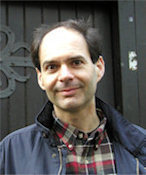 In the case of the Denisovans, most reactions I got were of the "my-mind-is-blown" variety. Some people felt that the Denisovan hypothesis now needed to be tested with some new evidence. (Finding another DNA-packed fossil bone won't be easy, but we living humans have lots of genomes waiting to be analyzed for Denisovan-like DNA.) But Joao Zilhao, an anthropologist at the University of Bristol (and about to take up a post at the University of Barcelona), offered a very provocative response.
In the case of the Denisovans, most reactions I got were of the "my-mind-is-blown" variety. Some people felt that the Denisovan hypothesis now needed to be tested with some new evidence. (Finding another DNA-packed fossil bone won't be easy, but we living humans have lots of genomes waiting to be analyzed for Denisovan-like DNA.) But Joao Zilhao, an anthropologist at the University of Bristol (and about to take up a post at the University of Barcelona), offered a very provocative response.
Zilhao has been unearthing lots of tantalizing evidence about Neanderthals on the Iberian Peninsula, including painted, drilled shells that they may have used as jewelry. He has also championed the idea that the 24,000-year-old skeleton of a child found in Lagar Velho in Portugal is a human-Neanderthal hybrid. Zilhao has long been at odds with what he sees as an extreme form of the "Out-of-Africa" model of human evolution–that is, that our ancestors expanded out of Africa and mingled not a whit with the hominins they encountered along the way–hominins that not coincidentally became extinct after we showed up in their backyards.
After Zilhao got back to me about the Denisovans, I decided not to include his response in the article. With a limited amount of space to describe the new paper and reactions to it, I felt that I should select a couple quotes that reflected the general reaction I was getting from other scientists. But his response is still worth reading. So here it is (I've added a few clarifications in brackets):
1) The authors conclude: "the emerging picture of Upper Pleistocene hominin evolution is one in which gene flow among different hominin groups was common." Such a picture may be "emerging" for the geneticists, but it has been argued for a long time on the basis of the fossils, namely Lagar Velho 1 and Oase 1 and 2, to mention but three that were found in the last 15 years and in whose excavation and study I was involved. It strikes me that aDNA [ancient DNA] researchers find it so hard to acknowledge the obvious: that their results strongly support Assimilation/Admixture models of modern human emergence and Neandertal/"archaic" demise put forth on the basis of the fossils and the archaeology and which, for a long time, they strongly opposed. The evidence eventually turned them around, and I suppose that's a good thing. But an honest acknowledgment of the implications of their findings in terms of the history of the debate would be befitting.
2) If the "Denisovans" are eventually shown to be anatomically archaic people indeed, the genetic evidence that they contributed to the Melanesians [people of New Guinea and surronding islands] is an important finding that, as the authors acknowledge, strengthens the case for the spread of modern humans across Eurasia to have featured admixture with local archaics as a rule, not as the exception.
3) But can we confidently assume that the "Denisovans" were indeed anatomically archaic? The two fossils [the finger bone and a molar] are largely undiagnostic, but note that the upper third molar is, in terms of size, identical to those of the Oase 2 cranium [more on Oase 2] , which is a "modern human with inherited archaic features." Moreover, the authors note the exceptional preservation of DNA in the phalanx, which, if anything, is suggestive of the fossil being young rather than old. Add to that the fact that the directly dated items found closest to the phalanx yielded mid-Upper Paleolithic ages and the parsimonious reading of the evidence is, to me, that the "Denisovans" are mid-Upper Paelolithic people that lived in the area somewhere between 30,000 and 15,000 years ago — i.e., I would not be surprised if, when more material is found, they will be shown to be "anatomically modern", even if "genetically archaic"!
4) We will not know for sure what the age of these remains is until they are directly dated (and the tooth could be, despite its small size, for instance, the age of the early modern human remains from Mladec, in the Czech Republic, was established by radiocarbon dating of teeth; cf. Wild et al 2005: 332-335; Nature 435), but let me stress that I have myself pointed out in different occasions that the stratigraphy of Denisova was disturbed to the extent that dating by association was unwarranted, and I am happy to see that, at last, the excavators acknowledge that such is indeed the case.
For instance, concerning the personal ornaments in level 11 (the same level where the phalanx was found), I wrote:
"A major discontinuity separates OIS-3 layer 11 of Denisova from the immediately overlying OIS-2 level 9, and the contact between the two is significantly disturbed. Because the range of ornaments from level 11 is identical to that found in both level 9 and the pockets containing level 9 lithics that penetrated deeply into level 11 (Derevianko and Shunkov, 2003, Fig. 7), their association with the IUP is questionable" (Zilhão 1997: 12-13; Journal of Archaeological Research, http://www.springerlink.com/content/t...) [pdf link]
And, where the age of the phalanx and its implications for the understanding of the DNA evidence are concerned, I wrote:
"These problems are compounded by the fact that archaeologists, anthropologists and media people (and even many geneticists) often mistakenly equate genetic 'lineages' (namely, mtDNA ones) with biological species. Take the recent realisation that the mtDNA extracted from a human phalange recovered in the cave site of Denisova, Siberia, belonged to a lineage that was even more distant from extant humans than the Neanderthals': this finding was hailed as evidence for yet another 'species' of human living some 40,000 years ago! However, the levels whence the Denisova phalanx came are so disturbed that the chances of that phalanx being 20,000 (or even 10,000) years old are as large as its being 40,000; until it is directly dated, we can't tell. In any case, the fossil simply goes to show the extent to which past human genetic variation was much higher than at present, something for which many clues exist even among the genes of extant humans." (Zilhão 2010: 6; Radical Anthropology, Issue 4, November 2010, http://www.bris.ac.uk/archanth/staff/...). [pdf link]
So, I suspect the "Denisovans" are in fact "modern humans." The future will tell, but that should surprise no one, because I see no reason to suppose that genetic lineages (however defined, namely via mtDNA [mitochondrial DNA]) that are very old and cannot be found any more among present day humans did not survive until a very recent past (in evolutionary terms). Until "globalization" events occurring in the last 10,000 years confused everything, that would be the thing to expect under a scenario where, at any given point in paleontological time, all humans belonged to a single biological species but one where, due to strong population structure related to geographical isolation, local extinctions and frequent recolonizations with attendant founder effects, there was a lot more variation in morphology and in genetics than there is today. To me, that's what the fossils have bee saying for the last 15 years, and the genetic evidence is simply adding further detail and further complexity to that scenario.

December 22, 2010
Meet the Denisovans, the newest members of the human tree of life
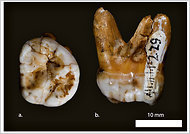 Last March I wrote here about a 50,000-year-old pinky bone found in a Siberian cave that might belong to a previously unknown kind of human. Scientists had isolated mitochondrial DNA from the bone, which suggested that it belonged to a separate lineage that was neither Neanderthal nor human.
Last March I wrote here about a 50,000-year-old pinky bone found in a Siberian cave that might belong to a previously unknown kind of human. Scientists had isolated mitochondrial DNA from the bone, which suggested that it belonged to a separate lineage that was neither Neanderthal nor human.
Well, the other shoe has dropped, and it turns out to be a big old boot.
In tomorrow's New York Times, I report on a new paper in Nature in which the scientists describe the nuclear genome they have now extracted from the finger bone. Its owner looks to be a cousin to Neanderthals, belong ing to a lineage that split off from them about 400,000 years ago. The members of this lineage have been dubbed the Denisovans, after the name of the cave where the pinky bone was found, Denisova.
But wait! There's more. First off, the scientists also got Denisovan DNA out of a tooth in the cave. It's a tooth unlike human or Neanderthal teeth, the scientists claim.
And there's more! Neanderthals interbred with the first humans to emerge out of Africa, it appears, judging from the presence of Neanderthal DNA in European and Asian genomes (but not African ones). Now it appears that Denisovan DNA is in the genomes of people from New Guinea, but no one else.
I know! New Guinea? Siberia? You can't get there from here!
There is so much to this story that I'm going to have to blog some more about it in the near future. For now, check out the article. All I want to say for now is that a week in which I get to write about a cannibal Neanderthal family massacre and a new lineage of humans known only from a pinky and a tooth–whose genes survive today even if they themselves do not–is the kind of week that refuels my love for science.
At the time, scientists were reporting on the 15,000 base pairs in its mitochondrial DNA that they had sequenced

Brain Cuttings: An Excerpt at Scientific American
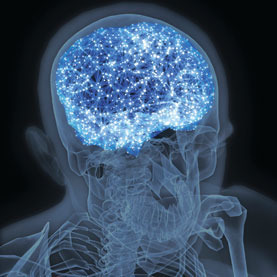 Scientific American is featuring an excerpt from Brain Cuttings, my new e-book about the frontiers of neuroscience. It's an account of my wanderings through the science fiction world of the Singularity, pondering whether we'll be uploading our brains someday to computers. The piece started out as an assignment for Playboy, which they published earlier this year; I then reworked the piece for the e-book. Check it out.
Scientific American is featuring an excerpt from Brain Cuttings, my new e-book about the frontiers of neuroscience. It's an account of my wanderings through the science fiction world of the Singularity, pondering whether we'll be uploading our brains someday to computers. The piece started out as an assignment for Playboy, which they published earlier this year; I then reworked the piece for the e-book. Check it out.
And if you have a subscription to Scientific American, please check out my feature in the January 2011 issue, called "100 Trillion Connections." There, I expand on one of the key topics I discuss in my e-book excerpt: how the brain is a network of networks (of networks), and only by understanding their organization will we finally come to terms with the complexity of the mind.

December 20, 2010
CSI: Neanderthal Family Massacre
In Tuesday's New York Times, I have an article about an unlucky group of Neanderthals, massacred and cannibalized 50,000 years ago. Through some detective work, scientists have determined that they were members of an extended family. Here's the paper (open access) if you want the gory details. While the interpretation the scientists present is not embraced by all the experts I contacted, they are excited at the prospect of this kind of fine-grained Neanderthal DNA sequencing. Of course, the lecture I gave last week now feels short a slide or two!

I Sing The Microbe Electric: New Podcast
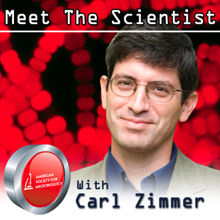 On my latest podcast, I talk to Jeff Gralnick of the University of Minnesota about electricity and life. In particular, we talk about how some bacteria generate electric currents as they feed–and how we might harness their power. Check it out.
On my latest podcast, I talk to Jeff Gralnick of the University of Minnesota about electricity and life. In particular, we talk about how some bacteria generate electric currents as they feed–and how we might harness their power. Check it out.

December 19, 2010
The Twelve Parasites of Christmas
Susan Perkins at the American Museum of Natural History is almost done with a truly heroic feat: overseeing a blog that features a new parasite every day in 2010. As we glide towards the end of the year, she's launched "The Twelve Parasites of Christmas." So far, mistletoe (that botanical equivalent of a tapeworm!), two turtle doves (and their blood parasites), and the cauliflower mushroom, bane of Christmas trees. What gifts await us in the next week?

DIY Tumors
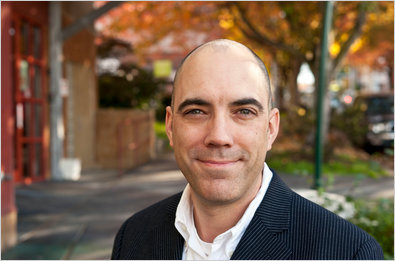 Last month I wrote a piece for the New York Times about what ten scientists are looking forward to in 2011. One of the scientists, Rob Carlson, saw garage stem-cell research in our near future:
Last month I wrote a piece for the New York Times about what ten scientists are looking forward to in 2011. One of the scientists, Rob Carlson, saw garage stem-cell research in our near future:
"It seems pretty likely within this year someone will show how to go from an adult peripheral blood draw to pluripotent stem cells. It means anyone who wants to try to make stem cells will be able to give it a whirl."
Carlson took to his own blog to write at more length about what exactly he meant. For one thing, stem cell biohackers may want to think twice before sticking stem cells in their own bodies. They could end up with what Carlson calls DIY tumors. Check it out.

December 17, 2010
The Red Headed Neanderthal: We're Live!
On Thursday, an excellent crowd turned out, despite the sharp cold weather, to hear me talk about Neanderthals. I managed to get a fairly good recording on my Iphone, and today I melded it with my slides on Imovie, to create a slideshow of the talk. I've embedded the Youtube and the Vimeo versions below. Take your pick.
























